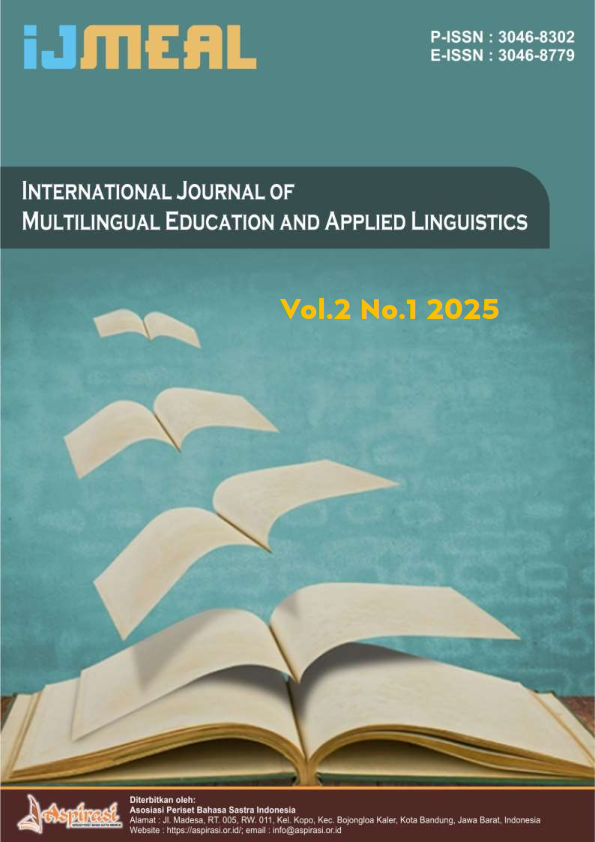Pronouncing English Triphthongs in Speaking for Workplace Communication
DOI:
https://doi.org/10.61132/ijmeal.v2i1.211Keywords:
Error Analysis, English Triphthongs, PronunciationAbstract
Pronunciation is one of the determiner aspects in English as it can change the meaning of the words and sentences. This research discusses the analysis of errors in the pronunciation of triphthongs in words and sentences in English. The research was aimed to know the types of triphthongs often mispronounced in the pronunciation of words and sentences in English among second semester students in class A of Speaking for workplace communication lecture at English study program of Madiun State Polytechnic. The quantitative were used after being collected from the assignments and pronunciation tests for several words and sentences containing triphthongs during the research. The research results are described in percentages. The diphthong errors that students often make are //aʊə /= 34.6%, /aɪə /= 31.8%, /ɔɪə /= 20%, /əʊə/= 9%, and /eɪə/= 4.6%. Errors that occurred in the classification of substitutions = 43.64%, insertions = 32.73%, and omissions = 23.63%. The errors occur due to the influence of inter-language and intra-language factors of the students.
References
Akinola, A. O., Oladipupo, R. O., & Gbadebo, B. M. (2024). A corpus-based study of patterns of triphthong realisation in educated Nigerian English. Journal of English Scholars’ Association of Nigeria, 26(2), 165–182.
Brinton, D., Celce-Murcia, M., & Goodwin, M. (2010). Teaching pronunciation: A course book and reference guide. Cambridge University Press.
Brown, H. D. (2001). Teaching by principles: An interactive approach to language pedagogy. Longman Pearson Education Inc.
Creswell, J. W. (2012). Educational research: Planning, conducting, and evaluating quantitative and qualitative research (4th ed.). Pearson Education Inc.
Cruttenden, A. (2013). Gimson’s pronunciation of English (7th ed.). Routledge.
Crystal, D. (2003). A dictionary of linguistics and phonetics (5th ed.). Blackwell.
Crystal, D. (2003). English as a global language (2nd ed.). Cambridge University Press.
Harmer, J. (2001). Book review: The practice of English language teaching. RELC Journal, 32(1), 135–136.
Ma, Q., Mei, F., & Qian, B. (2024). Exploring EFL students’ pronunciation learning supported by corpus-based language pedagogy. Computer Assisted Language Learning. Routledge Taylor & Francis Group.
Naveed, A., Batool, Z., Hameed, M., & Abid, M. A. (2024). Analyzing the communication performance of undergrads in English diphthongs and triphthongs. Contemporary Journal of Social Science Review, 2(4), 1970–1981. https://contemporaryjournal.com/index.php/14/article/view/289/250
Ngo, T. T. N., Chen, H. H. J., & Lai, K. K. W. (2024). The effectiveness of automatic speech recognition in ESL/EFL pronunciation: A meta-analysis. ReCALL, 36(1), 4–21. Cambridge University Press.
Omenogor, H. D., Fatima, F., & Oyakhire, O. (2012). Understanding some essentials of English language and its global status for enhanced productivity. Knowledge Review, 26(1), 104–112. http://www.globalacademicgroup.com/journals/knowledge_review/UNDERSTANDING_SOME_ESSENTIALS_OF_ENGLISH.pdf
Roach, P. (2009). English phonetics and phonology: A practical course (4th ed.). Cambridge University Press.
Rogerson-Revell, P. (2017). English vowels and consonants. In The Routledge handbook of contemporary English pronunciation (pp. 92–121). Routledge.
Yates, L., & Zielinski, B. (2009). Give it a go: Teaching pronunciation to adults. http://www.ameprc.mq.edu.au/
Downloads
Published
How to Cite
Issue
Section
License
Copyright (c) 2025 International Journal of Multilingual Education and Applied Linguistics

This work is licensed under a Creative Commons Attribution-ShareAlike 4.0 International License.





